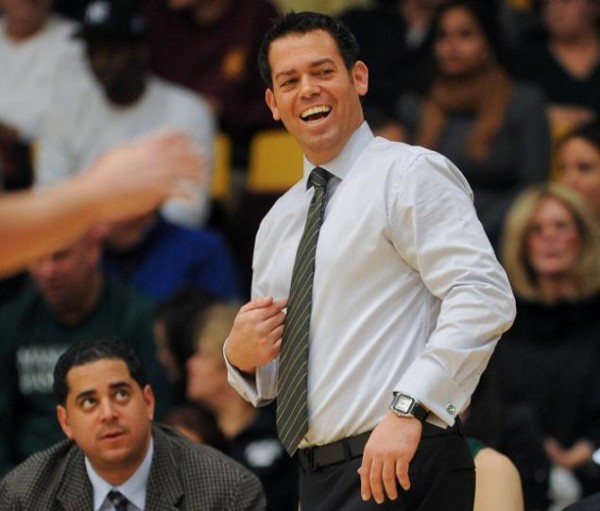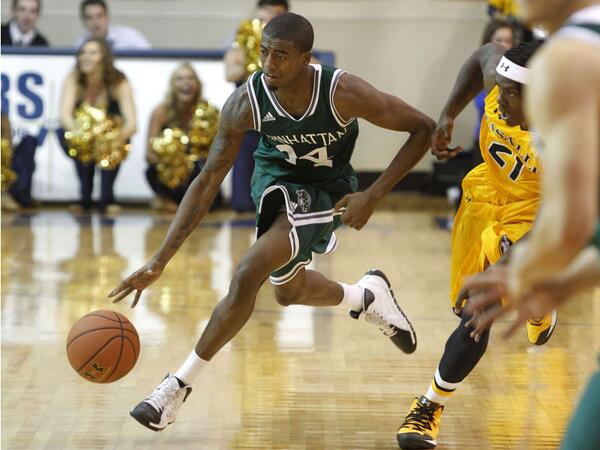Does Cinderella Reside in the Big Apple This Season?
Posted by Tommy Lemoine on January 6th, 2014In Ken Pomeroy’s recently-published conference race simulations, Manhattan wins the MAAC 6,161 times out of 10,000 simulations, which — in an 11-team league— makes it the overwhelming favorite. And for good reason. Despite being picked first in the conference preseason poll, the Jaspers have actually managed to exceed expectations in the first two months, using an aggressive defense and attack-first offense to notch several impressive road victories and an early 4-0 record in league play. So while fellow contenders like Iona, Canisius and Quinnipiac are likely to make the automatic bid far from a guarantee, Manhattan has already shown its potential as the most complete and dangerous upset threat from this league come March.
Iona has been the cream of this conference for the past two years, making the NCAA Tournament twice — including as an at-large bid in 2011-12, the second ever out of the MAAC — and doing so with exceptional offense. Tim Cluess’ up-tempo, free-flowing attack has yielded three straight top-30 finishes nationally in offensive efficiency and over 20 wins in each of those seasons. Their problem has often been on the other end of the court, as Cluess’ teams sometimes making a habit of playing porous defense for long stretches that the scoring cannot always overcome. Likewise, Saint Peter’s, the conference tournament champion in 2011, was one of the best defensive teams the league has ever seen (finishing fifth in the country in defensive efficiency), but it could not generate the offense necessary to become a threat in the Big Dance. Put simply, the NCAA Tournament’s MAAC representative has lacked balance in recent years.
And this is why Manhattan might be the conference’s best shot at a Tournament win since 2009: The Jaspers are not a one-trick pony. Defensively, head coach Steve Masiello — six years an assistant under Rick Pitino at Louisville — has implemented his mentor’s relentless pressure style to great effect since taking over in 2012, almost immediately turning his team into one of the best defensive groups in the MAAC. His team currently ranks in the top 40 in both steal percentage and turnover percentage, forcing over 21 miscues per 100 possessions, and often overwhelming opponents in the process. When teams are able to get into their offensive sets against Manhattan, they have to deal with the league’s best defensive player, 6’7″ forward Rhamel Brown, whose 18.1 percent block rate is good enough for second in the country. Brown is a long, athletic player whose intimidating (and often-game-changing) defensive paint presence is something of a rarity at the mid-major level.
On the offensive end, the attack unquestionably starts with George Beamon, a 6’4″ swingman who has had one of the most productive careers in league history. After redshirting last season due to an ankle injury, all Beamon has done since returning to the lineup is post his best numbers yet, averaging over 21 points and seven rebounds per contest and maintaining a stellar 119.9 offensive rating. Perhaps his best trait is his ability to explode to the rim like few other players in the MAAC, leading to regular trips to the free throw line if not made baskets. Point guard Michael Alvarado’s tendency to penetrate and either draw fouls or kick out to complementary pieces like Shane Richards and RaShawn Stores — together with Brown’s superb offensive rebounding — enables the Jaspers to score consistently and in a variety of ways, even if they don’t shoot the ball particularly well on a given night. The most important aspect of the attack might be their attack; Manhattan has the highest free throw rate in the country, getting to the line so often that freebies account for almost one third of its entire offense.

Steve Masiello has had many reasons to smile in the early part of 2013-14. (RON ANTONELLI/NEW YORK DAILY NEWS)
This level of completeness could portend great things for Masiello’s crew. Along with Niagara in 2009, the last MAAC teams to be as proficient on both ends of the court (a top-100 team in both offensive and defensive efficiency) were the Siena teams of 2008-10. Those three groups — led by current Iowa head coach, Fran McCaffery — were hugely successful in the NCAA Tournament, crushing Vanderbilt in 2008, beating Ohio State in overtime in 2009, and leading Purdue at the half in a first round loss the season after. The Jaspers have the firepower and mental toughness for similar success, having proven their mettle early this season with six non-conference road wins, including a double-overtime victory at La Salle and an 18-point dismantling of South Carolina in Columbia.
At 11-2, Manhattan currently projects as a #13 seed in Joe Lunardi’s most recent bracketology and has a chance to move up another line or two by season’s end. That is not to say the Jaspers don’t have concerns going forward — Brown has had spells of foul trouble in the first two months, and any off nights from Beamon could present problems, considering how heavily he’s relied upon — but there simply are not many teams in the MAAC able to compete with Manhattan on a nightly basis. Road games at Quinnipiac, Iona and Billy Baron-led Canisius still beckon, but even three or four conference losses would still likely be enough for the Jaspers to grab the top seed in the league tournament. If Masiello and his team hope to get their crack at an upset in the Big Dance, they will first need to take care of business in Springfield, Massachusetts — the top seed has failed to reach the MAAC championship game in each of the last three seasons. But if Manhattan does overcome that hurdle, it will no doubt be a very tough out in the opening weekend of the NCAA Tournament.










































